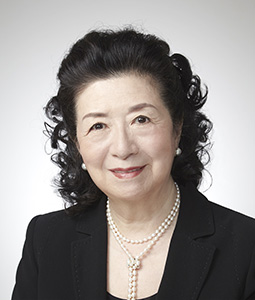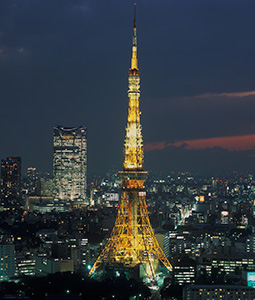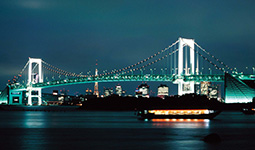July 2022
- English
- 日本語
A Master of Modern Japanese Lighting Culture

The Ginza Kabukiza Theatre in Chuo City, Tokyo 
Tokyo Gate Bridge in Koto City, Tokyo

Ishii Motoko 
Tokyo Tower in Shiba-koen park, Minato City, Tokyo 
Rainbow Bridge connecting Minato City and Koto City in Tokyo

Ishii Motoko is a leading Japanese lighting designer who has worked on the lighting for many buildings and landscapes and laid the foundation for modern Japanese lighting culture.

In recent years, there has been an increase in beautiful illumination of picturesque locations and famous buildings. Lighting designer Ishii Motoko has worked on the illumination of Tokyo Tower (333 meters tall) and many other famous buildings and landscapes, laying the foundation for modern Japanese lighting culture.

“The origin of Japanese lighting culture is moonlight. This is because ancient Japanese people revered and admired the light of the moon,” says Ishii. “Full moons in Japan have a gentle, hazy brightness due to the highly humid climate. There are limitless gradations connecting the light and the dark. It is quite different from the clear brightness of full moons in Europe and other places.”
Ishii values this ancient Japanese sensibility and has aimed for lighting design that utilizes it.
The Ginza Kabukiza Theatre in the district of Chuo City, Tokyo, a theater specifically for kabuki, is illuminated at night with light modeled on that of a Japanese full moon. The magnificent tiled roof is illuminated by the “moonlight” light source situated on top of the Kabukiza Tower 130 meters above the theater. A gentle light shines down from above, but it’s hard to tell where the light is coming from as no lighting device is visible. The white walls of the building’s facade are illuminated in slightly different white lighting each day of the year, transitioning from a cool white (blue-tinted white) in summer to a warm white in winter (orange-tinted white). This lighting reflects the Japanese sensitivity towards the changing of the seasons.
Ishii has worked on the illumination of more than 50 bridges, including the Rainbow Bridge (798 meters long) and the Tokyo Gate Bridge (2,618 meters long), both of which are known as symbols of Tokyo Port. As lighting up an especially large bridge can affect a fairly large area, Ishii gives paramount importance to harmony with the surrounding landscape. Rather than emphasizing the bridge itself, she designs the lighting so that the bridge rises up in gentle light while the surrounding area is also illuminated. In addition, her designs also take ease of maintenance into consideration. As many solar panels as possible are installed on the main towers that support the suspension bridges and in open areas near the bridge to maximize the effect of the lighting while greatly reducing power consumption.


The light reflected on the water fluctuates with wind and ripples on the surface, while darkness and light mix to create deep or pale gradations that change from moment to moment. Ishii says that this is one of the charms of bridge lighting, and that the fluctuating light offers different kinds of beauty at each moment of encounter.
“As the evening turns into the dark of night, the illuminated structure rises up. It is a performance of light, an ancient earthy drama, in which daytime is always followed by night. I believe the allure of lighting is in more beautifully expressing this majestic drama.”

